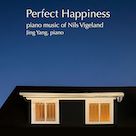

Nils Vigeland: Perfect Happiness
New Focus Recordings
With the release of Perfect Happiness, composer Nils Vigeland celebrates his seventy-fifth year on the planet and adds one more noteworthy achievement to an already illustrious career. While the fifty-minute set features solo piano pieces performed by Steinway Artist Jing Yang, Vigeland's output encompasses orchestral works, chamber material, and concertos extending from his first orchestral piece conducted by Lukas Foss and the Buffalo Philharmonic Orchestra in 1970 to his ninety-minute solo piano work, Pale Fire, based, of course, on the Nabokov work, which received its first performance in November 2023.
Born in Buffalo in 1950, Vigeland actually made his professional debut as a pianist the year before that 1970 concert, though again it was with the Buffalo Philharmonic Orchestra and Foss, with whom he also studied composition at Harvard College. Vigeland earned his doctorate at The University at Buffalo where his teachers included Morton Feldman and Yvar Mikhashoff and subsequently taught at the Manhattan School of Music for three decades before retiring in 2013. Over the years, Vigeland had a hand in premiering and performing works by pivotal figures such as Linda Bouchard, John Cage, Roscoe Mitchell, Phil Niblock, Pauline Oliveros, and Christian Wolff. He also participated in a number of fascinating projects, as the pianist in a trio that toured with Feldman as “Morton Feldman and Soloists” to perform his works for flute, percussion, and piano and as the director of The Bowery Ensemble, whose annual concerts helped promote music by composers associated with the New York School. The Chinese-born pianist Yang, herself a graduate of the Manhattan School of Music and The Juilliard School and a soloist and chamber musician who's performed throughout the world, shows herself to be a superb Vigeland interpreter on this portrait album, recorded in April and June 2024 at Mount Vernon's Oktaven Studios.
While Vigeland has created music for ensembles of many sizes, the acoustic piano holds a special place in his heart and has never ceased being a boundless outlet for his imagination. The resonance the instrument offers and the richness of a note's decay and sustain are for him endless sources of fascination. Being so sensitive to the acoustic properties of the piano, it's no surprise that a typical Vigeland piece is as much about the physical character of the sound as its melodic content and overall form. Each piece, as different as it is from the others, unfolds as an exploration of developmental possibilities and as a meditation upon them.
Such qualities are exemplified in the four pieces performed by Yang on this fine portrait album and that span almost thirty years. They're witnessed in Piano Sonata, whose first part was written in 1979 but whose closing two were completed in 2008. The opening part of the twelve-minute first movement, prosaically titled “I.,” strikes these ears as faintly reminiscent of Mussorgsky and Prokofiev, but beyond that registers as a full Vigeland statement. Like much of the material on the release, the music emerges in a fluid flow and with a sense of inevitability, no matter how unpredictable the route undertaken. The composer clarifies that the first movement includes two primary theme groups that develop and recapitulate, but the elements are so thoroughly interwoven it plays like a stream-of-consciousness improvisation. Rollicking and subdued expressions sit comfortably side-by-side, each segueing into the other, and playfulness and seriousness are both present. Equaling the first in duration, the conjoined second and third movements advance from the former's ABA design to the latter's two-part structure and coda. Again development occurs in accordance with an inexorable logic, the music progressing seamlessly from ponderous introspection to percussive dynamism and expressive rapture. The animated chordal oscillations that appear during one passage might hint at minimalism, but Vigeland's music is far too cagey to be tied to any one genre.
He used the dance collections of Schubert as his model for the animated vignettes composing 9 Waltzes and Ecossaise (1987), and its second and fourth parts are actual paraphrases of Schubert waltzes. After opening with a springy “Vivace,” the music settles into a relaxed dance in “Zart (attacca)” before the energy heats up in “Giocoso.” Like dancers taking a break to catch their breath, Vigeland's work does the same in working a less frenetic episode ("Inutile”) in amongst a livelier one (“Appassionata”). A spidery “Capricciosa” and creeping “Ostinato” also appear until the nimble-footed “Ecossaise” caps the engaging piece. Written for Mikhashoff, Mnemosyne (1987) is Vigeland's attempt to distill his one-time teacher's dual nature into compositional form, with the pensive first part intended to suggest his private, solitary side and the exuberant second the ebullience and extroversion of his public persona. Dedicated to his mother on the occasion of her eighty-first birthday, the four-part Perfect Happiness (2000) appeared to mystify some of Vigeland's Manhattan School of Music students when he gave its first performance. To their comment that the title of the piece “contradicted their impression of the music,” the composer replied that “happiness has many forms and sources.” Its sparkling opening movement is certainly radiant enough; its second, on the other hand, is noticeably more solemn, and the conjoined third and fourth unfold as a series of dramatic declamatory chords and jagged percussive flourishes—unusual evocations of happiness, to be sure.
Regardless, one visualizes Vigeland listening to the finished product for the first time and being delighted by Yang's inspired performances and proud of the material he created for the project—not boastfully proud but pleased by the artfulness of the result and the superb artistry of his interpreter. This is a recording that flatters both Yang and Vigeland, if in different ways and for different reasons.April 2025